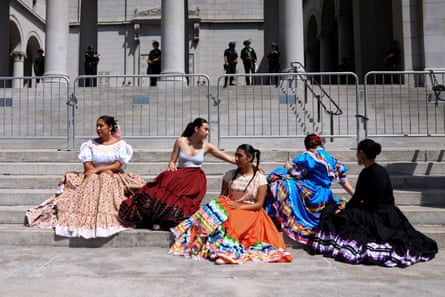Republicans are using images of Ice protesters waving Mexican flags atop burning Waymo cars to foment fear among Americans. Like this photograph that Elon Musk tweeted on Sunday: a shirtless protester wielding the Tricolor atop a vandalized robotaxi as flames billow toward the weak sunlight backlighting the flag. His dark curls fall to his bare shoulders. He stares into the camera.
Frankly, the image belongs in a museum.
I understand my reaction is not the feeling Republicans hope to inspire in Americans broadly this week. Their messaging thus far about the protests against immigration raids in Latino communities has largely been alarmist – proof, they say, of an “invasion” of “illegal aliens”.
“Look at all the foreign flags. Los Angeles is occupied territory,” said Stephen Miller on X. According to Adam Kinzinger, a former congressman and more moderate voice, the Mexican flags carried by protesters are “terrible… and feeding right into Donald Trump’s narrative”.
“I just think that it would be much stronger if they were carrying American flags only,” he said on CNN this week.
By this logic, Mexican flags are proof-positive that Mexican Americans are not really American; that we are somehow collaborating on a planned “invasion”; that we harbor secret loyalties to Mexico; that we’re here to displace white people and undermine the American way of life via some Plan Aztlan. In short, none of this is true.

In front of Congress Pete Hegseth, the defense secretary, cited the presence of “flags from foreign countries” in LA to legitimize supporting Trump’s deployment of the National Guard. This unilateral invocation of Title 10 by the Trump administration, without the consent of the governor, is exceedingly aggressive. So is the deployment of 700 US Marines to be used to crush American protest in an American city.
The subtext here is that by many metrics, American’s patience for Ice and its antics is wearing thin, even as Ice’s deportation numbers are anemic compared to past administrations. The Trump administration realizes something has to change. Fanning outrage about a flag is both a legal pretext to pursue martial law and a diplomatic means of getting consent from the American populace to do unpopular things in the name of security.
But what is it about the Mexican flag that triggers so many people?
I’d argue that in the American context, the Mexican flag is not a nationalist symbol but something decentered from Mexico as a nation-state. Historically, it was a key banner of the Chicano movement, flown by supporters surrounding Dolores Huerta and Cesar Chavez during the California grape boycott in the 1960s. It flew alongside the United Farm Workers flag, the American flag and banners of the Virgen de Guadalupe as means of fomenting cultural unity. It also served as a reminder of a fundamental truth: we are from here; we are also from there. We’re children of the in-between, or what the Tejanx writer Gloria Anzaldúa referred to as nepantla in her seminal work Borderlands/La Frontera. Nepantla is simply Nahuatl for the liminal space between cultures, identities and worlds. To this end, we might think of the Mexican flag as a symbol of double-consciousness in the Mexican American psyche specifically. We understand our middleness, yet we also understand how America sees and defines us: Mexicans. We take that prejudice and transform it into power.
It’s through this lens that I see the Mexican flag as just one banner among many, a remembrance of roots but also a shared experience between Mexican Americans and Mexican immigrants alike. Night after night, you can see captivating scenes with Mexican flags flying in the downtowns of Dallas and Houston and Atlanta and New York, as a solidarity grows between those explicitly targeted by Ice and those soon-to-be targeted by Ice. This is not hyperbole. Today, phenotype and politics are grounds enough for detention: in order for Ice to meet the Trump administration’s goal of 3,000 arrests per day, targets have increasingly included student protesters, tourists and even American citizens. The only rule is to meet the metric at all costs.
Amid these burgeoning protests, the Mexican flag is a bold articulation: we are like you; you are like us. We have struggled and persist in this place together. See me and don’t be afraid; I see you and I am not afraid. To wield the flag amid a protest is to paint yourself a target, to take both your body and your future into your own hands. This is precisely why the Marines have been called in. To intimidate these bodies. Or to destroy them.
What Trump fails to realize is that the bones of Mexican people are the metadata of the land in California and indeed the rest of the country. Our place here is in the food, in the street names, in the name of Los Angeles itself.
Already, I can hear some within my own community admonishing my defense of Mexican flags at American protests as treasonous or ungrateful or something along those lines. To them I might ask: why is it that the protester’s allegiances are held to higher standards than an American president who seeks to turn the US armed forces against American citizens?
From Republican leaders, you’ll never hear such questioning rhetoric surrounding other foreign flags that fly prominently in America. The Irish flag on St Patrick’s Day instantly comes to mind. As does the Israeli flag at both political and non-political events. And, of course, the Confederate flag, though white supremacists have explicitly stated goals of both overthrowing the US government and taking back US land. Heritage is the most commonly used defense. Though wouldn’t heritage apply to the Mexican flag as well?

I’m reminded of James Baldwin when Mexicans Americans and Mexicans call for restraint from using Mexican imagery in US protests: “In Harlem,” Baldwin wrote, “…the Negro policemen are feared more than whites, for they have more to prove and fewer ways to prove it.” We think our respectability will protect us. But we know historically and empirically that has not been true. Respectability did not protect Japanese Americans from being interned. Nor did it protect Vietnamese veterans who fought alongside Americans in Vietnam from facing discrimination in the US. Nor did it protect Afghan translators from having their visas revoked.
Our American bonafides are not the things that will save us now. Not in the era of detention metrics and collateral targeting and now the prospect of authoritarian violence.
It should be said: I don’t go looking for these images. For my sins, having clicked on one, the algorithm floods me with them now. Protesters with Mexican flags getting a haircut in front of police. Protesters with Mexican flags forming a human chain. They just keep coming to me. But other images, too. Like one of a guy popping a wheelie past a ton of burning Waymo cars. I mean, come the fuck on – it’s cool. The thing that immediately jumps out to me is the frivolity of the image. A body perfectly in balance, perfectly in motion. It moves of its own volition. It is completely in command of its trajectory and space in the landscape.
It is beyond the fascist impulse to live so beautifully as this. Luckily, it also is beyond the fascist ability to remove the memory of this body from the land.

.png) 3 months ago
40
3 months ago
40

















































